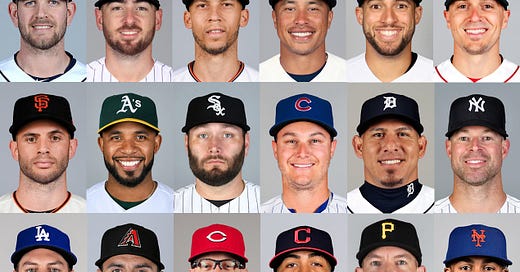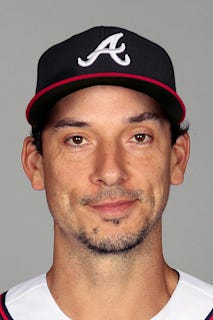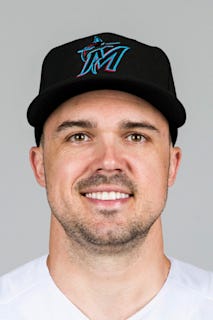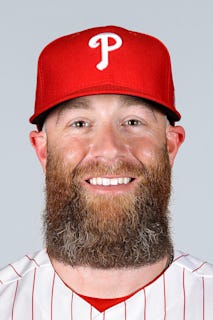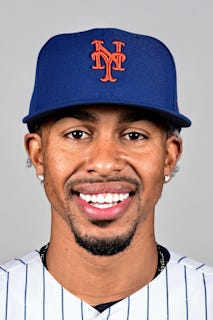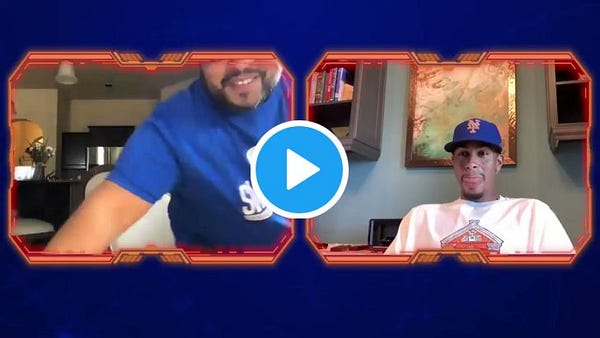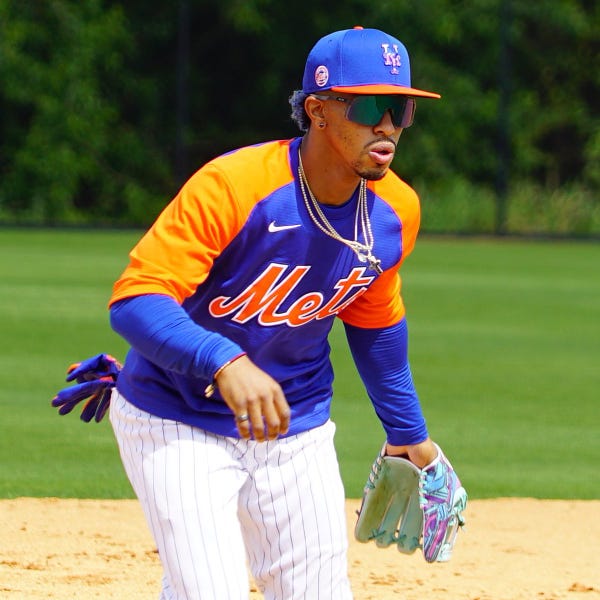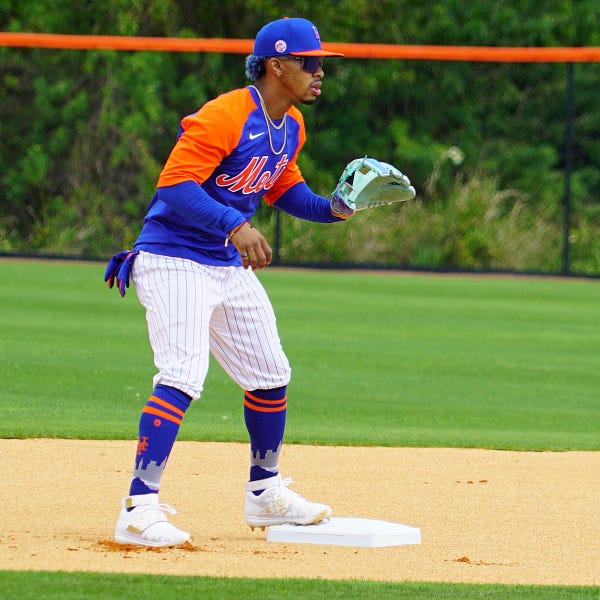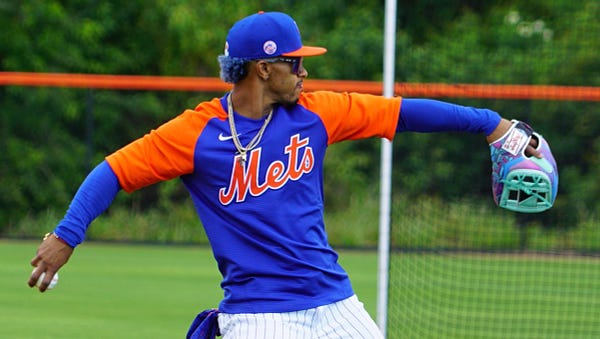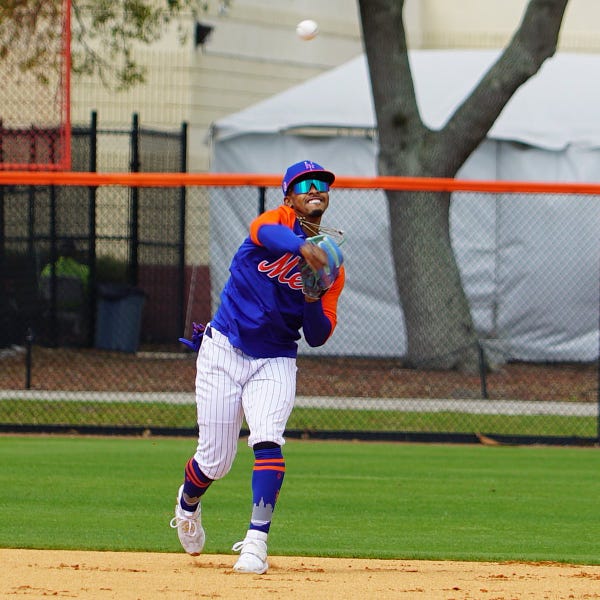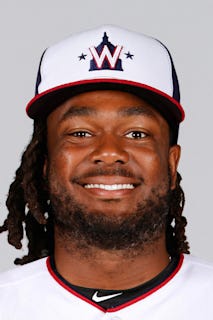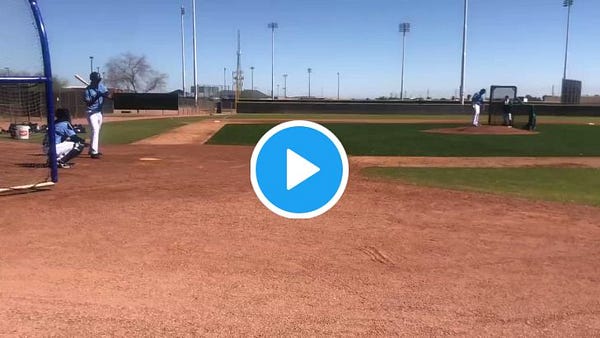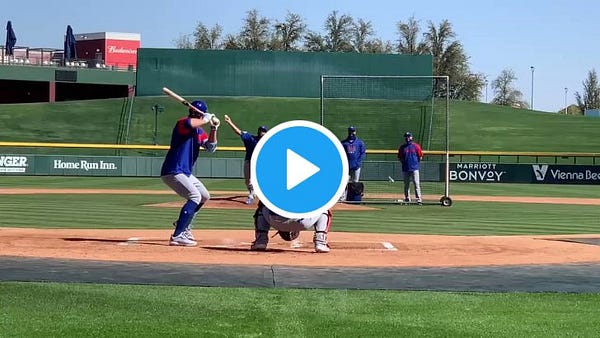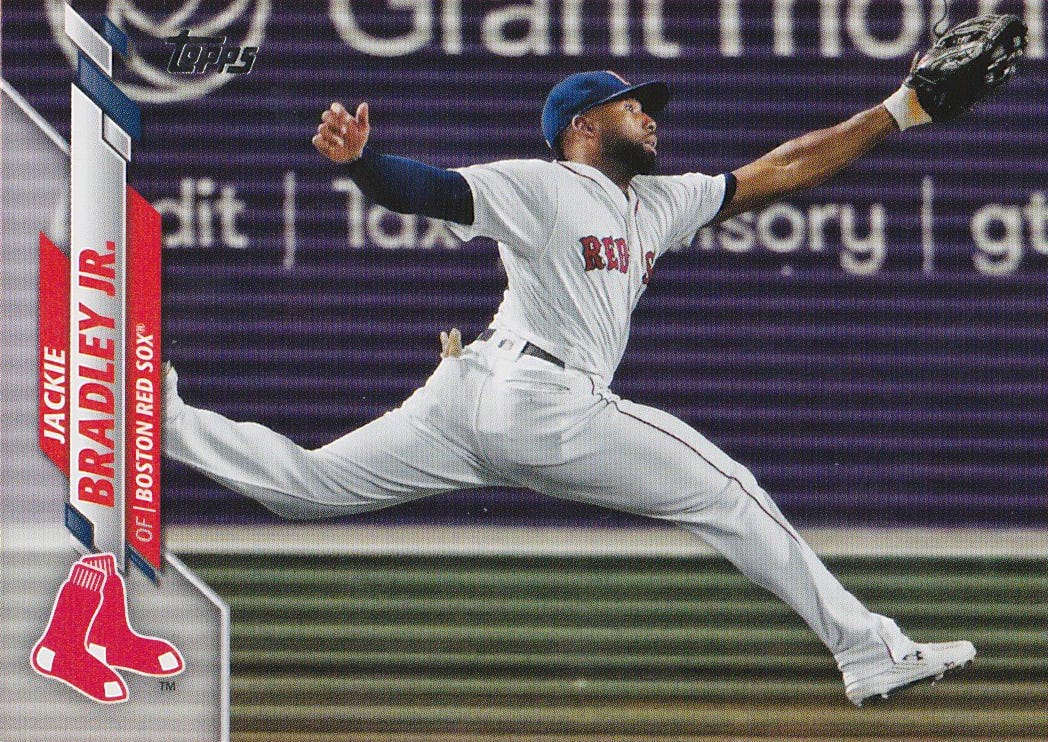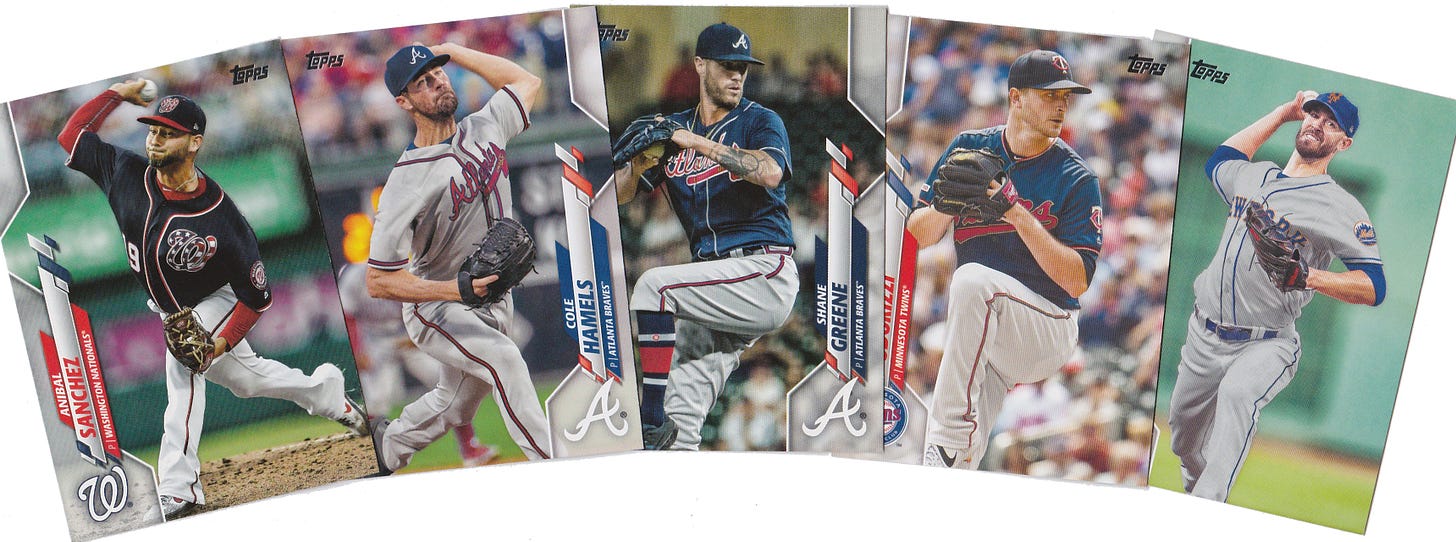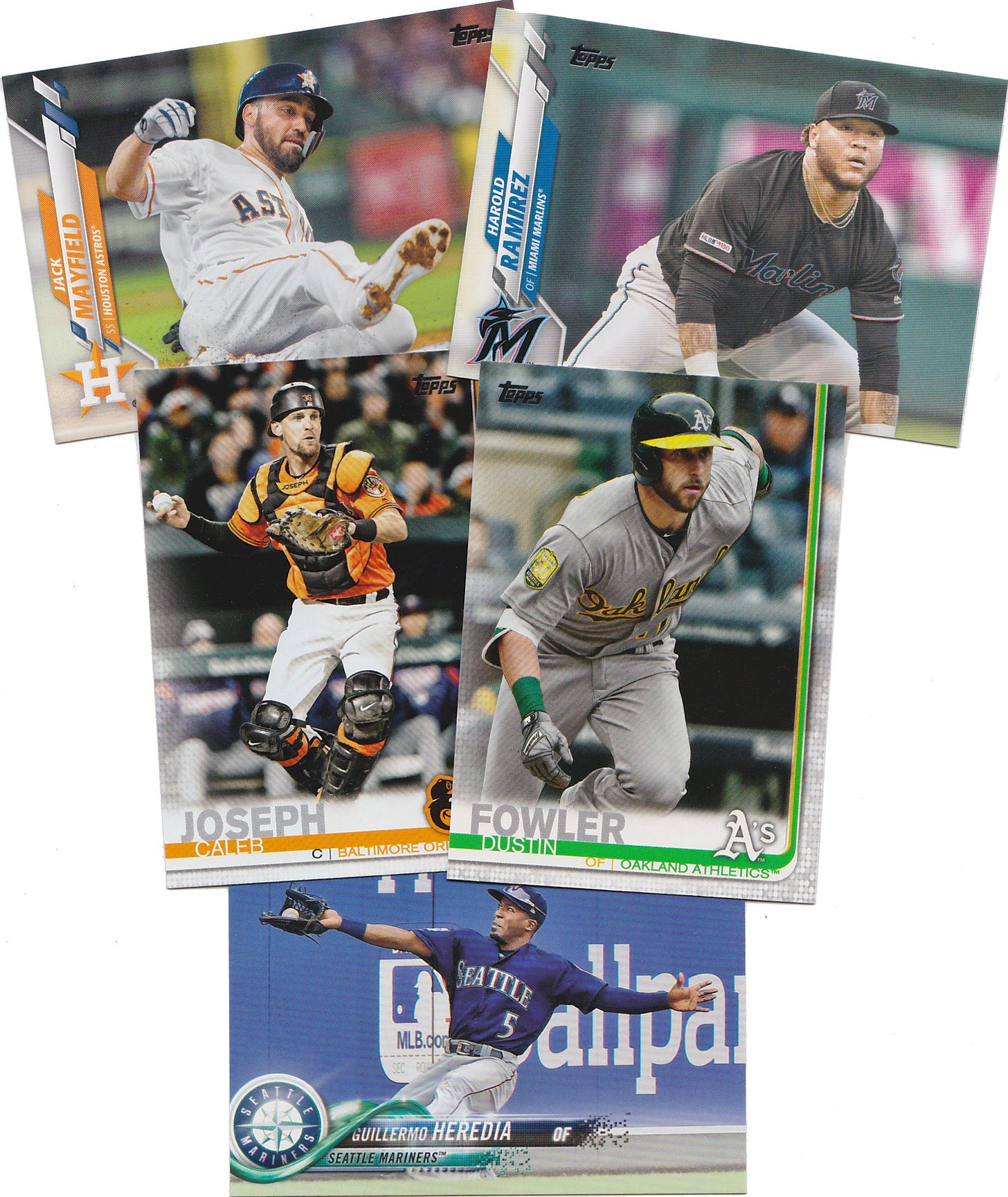The Cycle, Issue 15: Spring Training: Previewed
NL East Spring Training Previews, Sunday's exhibition openers, identifying the top 10 unsigned free agent hitters and pitchers, and more . . .
In this issue of The Cycle . . .
My Spring Training Preview series draws to a close with a look at the most compelling spring storylines for the teams in the National League East.
Also:
Attention Cyclists!
Play Ball! Sunday’s exhibition games
The Leftovers: Top 10 unsigned free-agent hitters and pitchers
Transaction Reactions: Caleb Joseph, Dustin Fowler, and some waiver claims
Aches and Pains: Royce Lewis, Alex Bregman, sliced fingers, and the ninth COVID case
Feedback
Closing Credits
Attention Cyclists!
I’m pleased to announce that, after ironing out some wrinkles behind the scenes, The Cycle is now accepting paid subscriptions. If you received this issue via email and have not yet upgraded to a paid subscription, or if you are a new subscriber reading this on Substack, you can click this button to sign up for a monthly, annual, or “supporter” subscription:
Also, if you know someone who you think would enjoy The Cycle—perhaps a baseball fan who is a bit less internet savvy but good at checking email, a younger fan on a tighter budget, or just a baseball fan in your life who doesn’t know about the newsletter yet—you can give a subscription to The Cycle as a gift using this button:
Today’s issue, which completes The Cycle’s fifth week of publication, is the last of the initial batch of free issues. Starting on Monday, only paid subscribers will be able to read The Cycle in full. As a bonus for paid subscribers, I will be opening comments on the site starting on Monday, so you can comment on each issue.
For those who already subscribe but don’t want to upgrade, do nothing and you will still receive the occasional free issue from time to time, though you will miss out on the majority of my coverage of the coming season. For those who want to sign up for the free issues only, you can do that, as well, via the button above (just select “none” for your subscription option).
As always, I thank you for reading and subscribing and hope you will help spread the word about The Cycle so we can grow our community and keep this thing going:
With that, let’s get to the baseball!
Spring Training Previews: NL East
Spring Training is underway, but the exhibition schedule doesn’t start until Sunday. To tide you over until we get to the actual games, and to give you some tips as to what to look for in those games, The Cycle has spent this week and last highlighting some of the more compelling spring storylines for each team in my Spring Training Previews.
Because one of the joys of Spring Training is seeing offseason acquisitions in their new uniforms, each team’s preview starts with the player that team and its fans should be most excited to see in their “New Duds.” I’ll then highlight the “Big Change” for each team, the thing that has changed most from last year to this; the “Big Battle,” that’s the position battle most likely to be decided by spring performance (even if the idea of evaluating players based on exhibition play is ridiculous and outdated); the “Big Question,” that’s the one unknown that might be answered before the season starts; an “NRI That-Guy,” a familiar major-league veteran who is in camp as a non-roster invitee; and, finally, the top prospect on that team whom we have yet to see in the majors but might get a “Sneak Peak” at this spring.
Here are the five divisions I have previewed thus far:
Today, we wrap up with the National League East before previewing some of this weekend’s action. As with my Offseason Report Cards, teams are presented in order of their 2020 finish.
Atlanta Braves
Location: CoolToday Park, Venice, FL
New Duds: RHP Charlie Morton
Re-signing Marcell Ozuna was the Braves’ biggest move this offseason, but Morton is their most significant addition. The 37-year-old righty comes full circle with his return to Atlanta. The Braves’ third-round pick way back in 2002, when Ronald Acuña Jr. was just four years old, Morton started 15 games for the Braves in 2008, then was traded to the Pirates in June 2009 in a four-player deal for outfielder Nate McLouth (when was the last time you thought about Nate McLouth?).
Morton spent the rest of his twenties as a middling and often-injured groundballer for Pittsburgh. Then he signed with the Astros as a free agent for his age-33 season, started throwing harder than he ever had before, and had three consecutive career years at the ages of 33, 34, and 35, making the All-Star team in the latter two and, after signing with the Rays, finishing third in the Cy Young voting in the last. That was 2019. In those three years, Morton posted a 131 ERA+ and excelled in the postseason, most famously pitching the final four innings, and getting the win, in Game 7 of the 2017 World Series. Last year, Morton battled shoulder pain and saw his velocity and effectiveness dip, so he’ll bear watching this spring, but he seems to have been victimized by a .355 opponents average on balls in play, which should correct itself over a larger sample. Despite the rough regular season, he went 3-1 with a 2.70 ERA in the postseason.
Big Change: Outfield
After six years as Atlanta’s right fielder, Nick Markakis is gone (though he remains unsigned). Adam Duvall, who was the Braves’ primary left fielder last year, is now a Marlin. With the designated hitter gone, Marcell Ozuna will be the full-time left fielder, and rookie Cristian Pache is expected to get the bulk of the work in center, locking Ronald Acuña Jr. into right field. That’s a whole new look for the Braves’ outfield, even if it is comprised of three players who were part of the team’s playoff run last year.
Big Battle: Centerfield
Speaking of Pache, while he is expected to ultimately be the team’s primary centerfielder this season, the Braves are going to make him beat out Ender Inciarte in camp. As manager Brian Snitker said last weekend, “I love what Pache did [in the postseason], but it’s like you tell all those young guys, ‘you don’t have a baseball card yet, so you’ve got to come in and earn your way.’” (Cue Lucy van Pelt again)
An elite defensive centerfielder, Pache graded out as the eighth-best prospect in baseball on the list I aggregated from the four main top-100 prospect lists. Pache showed off those fielding skills in last year’s postseason after an injury to Adam Duvall opened a spot in the outfield. He also homered and showed an ability to make contact against elite pitching, striking out just four times in 25 postseason plate appearances.
Pache’s hitting is what the Braves will be watching this spring. They know he can play the position. They’ll also watch Inciarte’s hitting carefully, as the veteran has posted a mere 82 OPS+ over the last three seasons. The possibility of a platoon (Pache is right-handed, Inciarte’s a lefty) looms, but the Braves aren’t likely to want to keep a talented 22-year-old limited to short-side duty, though they may opt to start Pache in the minors out of service-time concerns.
Big Question: RHPMike Soroka
As a rookie in 2019, Mike Soroka was an All-Star, the Braves’ ace, and finished second in the Rookie of the Year voting and sixth in the voting for the Cy Young award. Last year, he ruptured his right Achilles tendon attempting to cover first base in his third start of season. That would be a big deal if it happened last April, but it happened last August, so it’s a bigger deal. Soroka has had less than seven months to heal. He’s in camp and working out, but he’s doing rehab work on his legs more than he is warm-up work for the season. There’s some hope that Soroka could be in the Opening Day rotation, but that seems optimistic. With Max Fried, Charlie Morton, Ian Anderson, and Drew Smyly in the top four spots, and plenty of other young, talented pitchers on the roster (including Kyle Wright, Bryse Wilson, Huascar Ynoa, Touki Toussaint, and Sean Newcomb) the Braves don’t need to rush Soroka back. It’s more important that he’s fully recovered than ready for the first week of the season. Still, a healthy Soroka would be a boon to this club, so his making the Opening Day roster won’t be ruled out until it has to be.
NRI That-Guy: 2B Jason Kipnis
Pablo Sandoval finished last year in Atlanta and was on the postseason roster, so, although he is back as a non-roster player, I’m going with new arrival Kipnis here. A two-time All-Star and the starting second baseman on Cleveland’s 2016 pennant winners, Kipnis seemed like a foundational player for Cleveland as recently as five years ago. He then posted an 86 OPS+ over his last three years with the team and bounced to the Cubs last year, where he hit better, but in the small sample of 135 plate appearances. Kipnis played 25 games in centerfield in 2017 and ’18 combined, but, otherwise, he’s been exclusively a second baseman in the majors, which doesn’t make him a great fit for a team that already has Ozzie Albies. He’ll have to prove he can play other positions this spring to have a hope of making the club.
Sneak Peak: OF Drew Waters
The Braves’ top prospects are Cristian Pache and Ian Anderson, but both made their major-league debuts last year and are ticketed for significant roles on this year’s team. Waters, the team’s second-round pick from 2017, is the next in line, ranking 48th on my aggregate list of the game’s top prospects. A speedy, 22-year-old switch-hitter, Waters could be a centerfielder, but has no real chance of playing that position in Atlanta with Pache and Acuña ahead of him. That means his glove should play up in left, but he’ll need to hit well enough to carry the position. Waters hit .319/.366/.481 in Double-A in 2019, but his power, which is mostly doubles and triples, vanished upon a promotion to Triple-A, and he struck out 164 times in 134 games over the entire season. Still, the hope seems to be that the National League will get the designated hitter in the new collective bargaining agreement, Ozuna will return to that role, and Waters can ascend to left field in the next year or two.
Miami Marlins
Location: Roger Dean Chevrolet Stadium, Jupiter, FL
New Duds: OF Adam Duvall
Duvall was an All-Star with the Reds in 2016 and hit 64 home runs in 2016 and ’17 combined. He struggled at the plate in 2018 and was flipped to the Braves. As a part-timer over the last two years, he hit .248/.307/.545 with 26 home runs in just 339 plate appearances, but was non-tendered in December. Now, 32, he’s slated to be the Marlins’ full-time right fielder and will remain under team control next year.
Big Change: GM Kim Ng/expectations
On paper, the big change, not just for the Marlins but for Major League Baseball, is that Miami hired Kim Ng to be their general manager in November, making her the first female general manager in major-league history. I say “on paper” because, in practice, there’s nothing radical about a smart, experienced baseball person serving as a general manager. If you didn’t know who the Marlins’ GM was, nothing they did this offseason would give you any indication that there was anything unconventional about their general manager. Other than adding Duvall, Ng’s primary focus has been rebuilding the bullpen, adding Anthony Bass, who will compete with Yimi García for closing opportunities, Dylan Floro, John Curtiss, Adam Cimber, Ross Detwiler, and a pair of Rule 5 picks, Paul Campbell and the wonderfully named Zach Pop (who is one of four pitchers named Zach in camp with the Fish this spring).
In practice, the big change for the Marlins could be all of those new faces in the bullpen, but I’d argue that, after sneaking into last year’s expanded playoffs, the Big Change is that there are some expectations that this team will actually contend. Those are largely internal expectations, but they’re expectations that haven’t existed in Miami since before the Marlins’ last big fire sale.
Big Battle: Second base
According to the Miami Herald’s Craig Mish, Ng has positioned this as a head-to-head competition between Isan Díaz, who was the team’s Opening Day starter at second last year, and 23-year-old prospect Jazz Chisholm, with Jon Berti, who was ultimately the team’s primary second baseman last year, serving as more of a super-utility guy. Díaz was acquired in the Christian Yelich trade and hit .305/.395/.578 with 26 homers in 435 plate appearances in Triple-A in 2019. However, he started just two games at second last year before opting out when the Marlins had their COVID outbreak. Díaz, who will turn 25 in May, returned to the team in September, but played just five more games before suffering a season-ending groin strain. Chisholm, who was acquired from the Diamondbacks straight-up for Zac Gallen at the 2019 deadline, made his major league debut last year, but didn’t hit much in 21 games. A top-100 prospect (54th on my aggregate list), Chisholm has both speed and power but wasn’t great at Double-A in 2019 and has yet to play a regular-season game in Triple-A. The most likely outcome here is that Díaz gets the job and Chisholm heads to Triple-A as Plan B.
Big Question: Are the Marlins any good?
A question we might actually get an answer to in Spring Training is, “why did the Marlins put Jeff Brigham on the 60-day injured list?” (no explanation was given). The Big Question, however, is whether or not this team will actually be competitive, or if their playoff berth last year—which ruined the fun fact that the Marlins had won the World Series every time they had made the playoffs yet had never won their division—was just a small-sample/expanded playoff fluke. All evidence suggests the latter. The 2020 Marlins were just a game over .500 (31-29) and were outscored by 41 runs. Still, they have a talented young rotation, Ng built up the bullpen, and their lineup is suddenly comprised of competent veteran hitters, with Duvall joining Corey Dickerson, Brian Anderson, Miguel Rojas, a rejuvenated Jesús Aguilar, and last year’s deadline addition Starling Marte. If Díaz can stay healthy and play up to his minor league track record, the Marlins still probably won’t be full-blown contenders, particularly in this division, but they might actually be good.
NRI That-Guy: C Sandy León
León’s 122 OPS+ in 2016 proved to be even more fluky than it seemed at the time (he has a 51 OPS+ in 861 plate appearances since), but he did go 3-for-6 with a double and a walk in the 2018 World Series and remains the rare recognizable backup catcher, though I don’t imagine he’ll bump Chad Wallach off the Opening Day roster.
Sneak Peak: RHP Max Meyer
Sixto Sánchez and Trevor Rogers are both top-100 prospects who should break camp in the Marlins’ rotation. Max Meyer falls between them on the aggregated list as the game’s 33rd-best prospect and is a bit further away having just been drafted third overall, out of the University of Minnesota, last year. Meyer, who will turn 22 in March, has triple-digit heat and a wicked slider. He’ll work on a third pitch in the minors this year.
Philadelphia Phillies
Location: Spectrum Field, Clearwater, FL
New Duds: RHP Archie Bradley
Like the Braves, the Phillies’ big moves were keeping, not adding players. Re-signing J.T. Realmuto and Didi Gregorius was a big win for the Phils, but it won’t be weird to see those two in Phillies uniforms in camp. Seeing Bradley’s big beard hovering over those blue stars, however, that might be a bit odd. A former seventh-overall pick and elite starting pitching prospect, Bradley found a home in the bullpen in 2017 and has posted a 152 ERA+ in 221 games since, saving 28 of those. He will challenge Héctor Neris for closing opportunities this year.
Big Change: The rebuild momentum has stalled
The Phillies’ narrative in the second half of the 2010s was a rebuild and return to contention. That was supposed to yield fruit starting in 2018, under new manager Gabe Kapler. The Phillies improved by 14 wins that season, but still finished below .500. In 2019, they added Byrce Harper, J.T. Relamuto, Jean Segura, and Andrew McCutchen—the big spend that is supposed to be the final step of any rebuild—but only improved by one game. That earned Kapler his walking papers. Last year, they replaced Kapler with Joe Girardi, who won Manager of the Year in the only losing season among his 11 as a major-league skipper prior to last year. They got worse. For all of the talent the Phillies have graduated and acquired over the last half decade, they still haven’t outscored their opponents over the course of a season since 2012. The Phillies are not sticking the landing, and the momentum they had coming into this new decade has stalled. The expectations are gone. The Braves are the dominant team in the East, the Mets are ascendant, the Nationals got their title, and the Phillies are left trying not to finish behind the Marlins.
Big Battle: Centerfield
The Phillies’ second-round pick in 2011, Roman Quinn got the bulk of the playing time in center last year, but he’s a career .235/.306/.364 (78 OPS+) hitter, was worse than that last year, he’ll turn 28 in May, and, for all of his speed, he hasn’t graded out as a particularly good defender at the position. Adam Haseley, the eighth-overall pick in the 2017 draft, hasn’t impressed much, either, hitting .269/.330/.382 (87 OPS+) over his first 334 major-league plate appearances while hitting an excess of groundballs. He has been better in the field than Quinn, though, and he won’t turn 25 until April. Then there’s Scott Kingery, who can’t seem to find a position. Kingery started 57 games in center in 2019, but was pretty lousy in the field, and he’s been lousy at the plate in two of his three big-league seasons. That’s three players who were all highly regarded on their way up who have failed to validate those evaluations in the majors, none of whom projects to be a benefit to the team at the position, but all of whom the team would like to see realize their potential. A platoon of the lefty Haseley and either righty Kingery or switch-hitter Quinn (who has been better from the right side thus far) is one possible solution.
Big Question: What is the team going to do with ScottKingery?
In 2017, Kingery, the Phillies’ second-round draft pick two years earlier, hit .304/.359/.530 with 26 home runs, eight triples, and 29 stolen bases in a season split between Double- and Triple-A. That winter, he was widely regarded as something like the 31st best prospect in baseball. In late March of 2018, the Phillies signed Kingery to a six-year, $24 million contract and put him on their Opening Day roster. Primarily a second baseman in the minors, Kingery played every position other than catcher and first base that year (yes, he pitched), but mostly shortstop. Despite getting 484 plate appearances, he managed a mere .226/.267/.338 (61 OPS+). In total, he was a win below replacement level, per Baseball-Reference. As a 25-year-old sophomore in 2019, Kingery again played nearly every position (but didn’t pitch), this time mostly center and third base. He was better. That year, he hit .258/.315/.474 (101 OPS+) with 19 homers, four triples, and 15 steals and was close to a three-win player. Last year, however, his bat was ice cold even before he contracted COVID-19 in early September. Spending most of his time at second base, but playing poorly in the field, he hit just .159/.228/.283 (37 OPS+) and neither tripled nor stole a base in 36 games.
This spring, the Phillies are going back to Jean Segura at second base, which leaves Kingery . . . where exactly? He was lousy in center, he’s blocked at second and shortstop. Alec Bohm’s defense is a problem at the hot corner, but Bohm’s bat is one the Phillies would still prefer to keep in the lineup. A right-handed hitter, Kingery could spell Didi Gregorius or Adam Haseley against lefties, but he doesn’t have a position, yet he needs playing time to try to prove that last year was a small-sample fluke and that he can build on 2019. He’ll turn 27 at the end of April, so his development time is running short, and he’s under contract through 2023, so the Phillies would like to see him be a useful major leaguer, but how, and where? A trade could be in the offing, but the return would be slight. It will be interesting to see what the team does with him this spring.
NRI That-Guy: RHP Neftalí Feliz
Phillies camp is thick with non-roster veterans, including Matt Joyce, Jeff Mathis, Iván Nova, Hector Rondón, and Tony Watson, not to mention curiosities such as Christian Bethancourt, the busted catching prospect who tried pitching and spent 2019 in the KBO, and Ronald Torreyes, Joe Girardi’s pocket pet. The ultimate that-guy in Phillies camp, however, is former Rangers’ closer Neftalí Feliz. Best remembered as the 2010 AL Rookie of the Year and for blowing the save in Game 6 of the 2011 World Series, Feliz had Tommy John surgery in late 2012, missing most of the 2012 and ’13 seasons, bounced back in 2014, but has been a struggling journeyman ever since. He posted an 84 ERA+ for five teams from 2015 to ’17 (a three-year span), spent 2018 in the minors experimenting with a return to starting, and hasn’t pitched in affiliated ball since. Somehow, he won’t turn 33 until May, but he hasn’t pitched in the majors since 2017. I haven’t the first clue as to what to expect from him in camp.
Sneak Peak: RHP Francisco Morales
Spencer Howard made his major-league debut last year. Mick Abel, the team’s top pick last year, is a teenager and not in camp. Third on the Phillies’ prospect list is Francisco Morales, a right-hander like the other two and a member of the 40-man roster. A skinny, 6-foot-4 Venezuelan, Morales was a teenager in A-ball when he last donned a uniform, as he was not at the alternate training site last year. It will be interesting to see how his mid-90s heater and nasty slider look this spring and to which level the Phillies send him the season starts.
New York Mets
Location: Clover Park, Port St. Lucie, FL
New Duds: SS Francisco Lindor
Last week I crowned Nolan Arenado the “New Duds” champion because, in addition to being a franchise-level player switching teams, he was also making a dramatic wardrobe change, going from the Rockies’ black to the Cardinals’ red. Despite that, Lindor is the player I’m most excited to see on his new team. That’s not because of the team or the wardrobe. It’s because of the player. Lindor isn’t just a great player (only seven active players, from Albert Pujols to Mookie Betts, compiled more wins above replacement prior to their age-27 season than Lindor has heading into his age-27 season). He’s a beam of light, a pure joy to have in baseball, and I fully expect his star to go supernova in New York. That’s partially because I expect him to rebound from his disappointing 2020 season, but also because he has a huge personality that will be utterly at home in the country’s biggest media market. I mean, this is a guy nicknamed “Mr. Smile,” who showed up to camp on Thursday in the Coming To America jacket:
And was doing fan outreach within days of joining his new team:
As for those New Duds, he looks good in the blue and orange, but check out the hair and the glove . . .
Big Change: Ownership and optimism
In certain circles, “Mets” gets equal use as a verb and a noun, and not in a flattering way. The Mets always seem to find a way to Mets things up, but since Steve Cohen bought the team in November, finally freeing the team and its fans from more than three decades of ownership by the Wilpons, something like genuine optimism has started to take root around the team. The Mets earned the lone A+ in my Offseason Report Card series, they’ve landed a genuine superstar in Lindor, upgraded at catcher, in the rotation, in the bullpen, and on the bench, and they still haven’t spent the kind of big money they might on next year’s far more compelling free-agent class. They also dispatched an offseason scandal (the revelations about now-former general manager Jared Porter) with quick, decisive, and correct action from ownership and walked away relatively clean. Can we make sense of a world in which the Mets are not only good but competently and responsibly run? The mind reels.
Big Battle: Dominic Smith vs. left field
With the designated hitter gone, there’s really just one way for the Mets to get all of their best bats in the lineup: put Pete Alonso at first, Jeff McNeil at second, J.D. Davis at third, and Dominic Smith in left field. The problem is that none of those guys are particularly good fielders at those positions. Smith in left, however, is both the worst and the key to the whole arrangement. If Smith can’t play a passable left field, the plan explodes. You have to take at-bats away from Alonso to get Smith in the lineup, and a lesser bat has to fill the hole, be it in left or at second base by moving McNeil to left. The Mets have prepared for those contingencies by stocking the bench with Jonathan Villar, Kevin Pillar, José Martínez, and Albert Almora Jr., but the best solution is to have Smith wrestle the far pasture to a draw, or at least indicate that he’s capable of that doing so before Opening Day arrives.
Big Question: Will the team extend Lindor before Opening Day?
As exciting as the Lindor acquisition was and is, to make it really matter, the Mets have to lock their new star shortstop up beyond this season. The Dodgers got this exactly right with Mookie Betts last year, but, because of the delayed start of that season, they had until late July to work out a deal before Opening Day. The Mets have a month, and the market is astronomically high. If fellow shortstop Fernando Tatis Jr.’s 14-year, $340 million deal doesn’t seem perfectly relevant because Tatis is so much younger, remember that Betts, like Lindor is this spring, was entering his age-27 season last year when the Dodgers gave him 12-years and $365 million. I expect it will take something similar to lock up Lindor, who just joined the organization and has to decide if this is where he wants to spend the rest of his career. On Monday, Lindor said that there is “mutual interest” in an extension, but he also said there have been no discussions as of yet and that “it’s too early.” Still, if the Mets don’t have Lindor locked up by Opening Day, it will be both surprising and disappointing.
NRI That-Guy: C Bruce Maxwell
The Mets have more accomplished major leaguers among their non-roster invitees, but Maxwell is the most notable. It’s not just that Maxwell was the first major leaguer to kneel during the national anthem back in 2017. It’s what happened after. As detailed in an outstanding piece by ESPN’s Howard Bryant last July, the blowback Maxwell got for that simple gesture was devastating, both to his career and his mental and emotional well-being. Maxwell found some peace of mind in 2019 in the Mexican League, where he hit .325/.407/.559 with 24 homers and 112 RBI, but he was an exile from both his country and the highest level of his profession. Just a few weeks after Bryant’s article was published, the Mets signed Maxwell to a minor league contract, and Maxwell spent last year’s abbreviated season at their alternate training site. This year, he’s in camp hoping to climb back onto a major-league roster, be it the Mets’ or, via the opportunity to showcase himself this spring, someone else’s. At 30, Maxwell isn’t likely to be anything more than a fringy backup catcher. He was never a top prospect, and never hit for power in the minors. Still, Baseball owes him, and I hope some team pays up this spring.
Sneak Peak: C Francisco Alvarez
Alvarez, who ranked 44th on my aggregated prospects list, is a Venezuelan teenager who hasn’t played above Rookie ball, so he is quite a distance from the majors, but he was at the alternate training site last year and will be in major-league camp this spring. Reports say the 19-year-old possesses every tool you could want from a catcher, on both sides of the plate.
Washington Nationals
Location: The Ballpark of the Palm Beaches, West Palm Beach, FL
New Duds: 1B Josh Bell
Sure, if you’re going by accumulated major-league accomplishments, or by familiarity with a given player in a uniform other than this one, that should be Jon Lester or even Kyle Schwarber’s face in that picture. To my mind, however, Bell is the new addition about whom Nationals fans should be most excited. A well-regarded prospect, Bell finished third in the Rookie of the Year voting in 2017, improve his plate discipline in 2018, and had a breakout year in 2019, hitting .277/.367/.569 with 37 homers and 116 RBI on a lousy Pirates team. He was awful last year, but I’m optimistic about what Kevin Long and assistant hitting coach Pat Roessler can do to fix what was obviously either a bad approach or bad mechanics last year. Bell is just 28 and will remain under team control next year.
Big Change: Uncertainty about the rotation
When the Nationals won the World Series in 2019, they did it in part on the strength of one of the best starting rotations in baseball. Perennial Cy Young candidate (and three-time winner) Max Scherzer, World Series MVP Stephen Strasburg, new addition Patrick Corbin, and wily veteran Aníbal Sánchez were all somewhere from good to great both coming out of 2018 and throughout 2019. However, Scherzer is now 36 and starting to show his age. Strasburg barely pitched last year due to carpal tunnel syndrome, which he had surgery to correct in August. Sánchez is gone, replaced by fellow 37-year-old Jon Lester, who looks to be on his last legs as a major-league pitcher. Even Corbin, the youngest and healthiest of the bunch, had a bad year in 2020. What can the Nationals get out of that group, plus a fifth starter selected from Joe Ross, Erick Fedde, and Austin Voth? It remains to be seen.
Big Battle: Fifth starter
Some have mentioned righty Rogelio Armenteros as a fourth contender for this spot along with Ross, Fedde, and Voth. Armenteros was claimed off waivers twice this offseason (he took a two-week detour through the Diamondbacks on his way from the Astros to the Nationals) and, frankly, I’d be shocked to see him win this job outright. As for the other three, Voth made 11 starts last year and was awful. Fedde made eight with decent results but lousy peripherals. Ross opted out of the season (as did his brother, Tyson) and was pretty lousy in nine starts and 18 relief appearances in 2019. So there is no favorite here, though there is some indication that the Nationals would prefer to see Ross, the youngest of the bunch at 27, claim it, but are worried about him coming back from a full season of inaction.
Big Question: How is healthy Strasburg?
Bell’s ability to bounce back from last year is a big question, but the health of Strasburg, the player to whom the team has made the longest and most expensive commitment ($35 million a year through 2026, his age-37 season) is the Big Question. The early indications have been good, but the Nats will be watching him even more closely than usual as he ramps up to the regular season.
NRI That-Guy: 1B/OFYasmany Tomás
Nationals fans will surely be happy to see Gerardo “Baby Shark” Parra back in a Nats uniform this spring after spending 2020 with the Yomiuri Giants. However, I’m more fascinated by the invite extended to Yasmany Tomás, the Cuban slugger the Diamondbacks signed to a six-year, $68.5 million contract back in November 2014. The Diamondbacks thought Tomás might be able to play third base. It turned out, he wasn’t even all that qualified to patrol the outfield, which was a problem for a team with Paul Goldschmidt but no DH. Tomás hit 31 homers in 2016, but didn’t walk much and wasn’t productive enough to overcome his defensive liabilities. By early June 2017, Arizona had shipped him down to Triple-A and moved on. That deal finally expired last year, so Tomás, now 30, is trying to salvage a major-league career. He hit .301/.341/.590 with 29 homers in 102 games in Triple-A in 2019 and .280/.312/.528 in 825 career at-bats at the level. That last isn’t a far cry from what he’s capable of, but he’s not a different player than he was in 2017. He has power, won’t take walks, and shouldn’t really play anywhere other than first base. With Josh Bell and Ryan Zimmerman ahead of him, that leaves no room for Tomás on the Nationals. He’ll try to turn some heads this spring, nonetheless.
Sneak Peak: RHP Cade Cavalli
The only player in the Nationals’ system to make a top-100 prospect list this year, Cavalli was ranked 99th by MLB Pipeline and not listed by anyone else, placing him 143rd on my aggregated list of the 144 prospects to appear on a list this winter. That doesn’t mean he’s bad, but he’s no blue-chipper. The Nats’ first-rounder from last year (22nd overall), Cavalli is a big right-hander from the University of Oklahoma with upper 90s heat and a good curve and slider. If you see him pitch this spring, watch his control, it was awfully shaky in his first two years at Oklahoma, and, while it was outstanding in his junior year, that was over just four starts prior to the shut-down.
***
In celebration of the completion of my Spring Training Preview series, here’s an image I made with the headshots of all 30 of the New Duds dudes (arranged roughly geographically, as opposed to by division). I didn’t shape it to a phone, tablet, or laptop screen, but, if you tile it, it makes for fun desktop wallpaper. Everyone’s wearing the wrong hat!
Sunday! Sunday! Sunday!
Actual baseball games!
The exhibition season begins on Sunday with 14 games. We will never see all 15 teams in action on any given day during the exhibition season because there are 15 teams in Arizona and 15 in Florida, the odd number requiring one team in each state to sit out each day’s action. On Sunday, the Cubs will be idle in Arizona, while the Mets will sit out in Florida. Both of those teams will start their exhibition seasons on Monday, instead.
Of the 14 games, only three are currently slated to be available on MLB.tv:
1:05pm EST: Blue Jays @ Yankees
1:05pm EST: Nationals @ Cardinals
3:05pm EST: Brewers @ White Sox
Pitching plans for those three games have not yet been announced. I don’t plan to overly scrutinize the Grapefruit and Cactus League action, but since these are the first games of the year, I will have some recap of at least the televised action in Monday’s newsletter.
In the meantime, the hot action on Thursday was live bullpen sessions, which gave us two compelling confrontations via the phones of intrepid beat writers. First, from the Seattle Times’ Ryan Divish, here’s a full at-bat by 20-year-old Mariners outfielder Julio Rodríguez, the fifth-best prospect in baseball, against 24-year-old lefty Justus Sheffield, who will be a sophomore in the Seattle rotation this year:
This second one requires less explanation. From Chicago Sun-Times reporter and award-winning cinematographer Russell Dorsey, Kris Bryant vs. Jake Arrieta, with a predictable outcome:
Yay, baseball!
The Leftovers: Unsigned Free Agents
As you’ll see in the next section, the well of compelling transactions is starting to dry up as the exhibition season approaches. That doesn’t mean that every worthy player has found a team, however. By my count, there are still nearly 50 unsigned free agents who finished the 2020 season in the majors, on the major-league injured list, or who are major-leaguers who opted out or sat out of the 2020 season. Some of those players will land major league deals, more may yet land minor league contracts, but not all of those players will find teams. This is how some careers end.
In order to rank those that remain, I calculated a weighted average of their wins above replacement (Baseball-Reference formula) from the last three seasons, pro-rating their 2020 totals to 162 games and using a 5/4/3 weighting scheme (with the more recent seasons receiving more weight). By that metric, here are the top 10 hitters and pitchers who remain unsigned:
Hitters
1. Jackie Bradley Jr., CF (3.55 weighted bWAR)
Bradley ranked tenth on my list of unsigned free agents a month ago, when J.T. Realmuto, Trevor Bauer, Marcus Semien, Justin Turner, and Nelson Cruz were still among the unsigned. He is easily the best of the players that remain unsigned, at least in terms of recent on-field production. On the downside, he is a 30-year-old who derives a great deal of value from speed and defense, and he’s a left-handed hitter with platoon vulnerabilities and a career 94 OPS+. Still, there are several teams that need help in centerfield, many of whom continue to inquire about Bradley. He should sign soon.
2. Edwin Encarnación, DH/1B (1.14)
Encarnacion is 38, coming off an awful year at the plate, and really only viable at designated hitter, but he hit .244/.344/.531 with 34 homers in 486 plate appearances in 2019 and has been one of the most consistent run producers in the game over the last decade.
3. Jedd Gyorko, IF (1.09)
As he has moved into his thirties, the 32-year-old Gyorko has become less of a utility infielder and more of a corner man, but he had a great year at the plate in 2020, and has been a league-average bat with some pop over the course of his career. Yet, the Brewers declined his $4.5 million option at the end of Ocotber, and no one else has snatched him up.
4. Maikel Franco, 3B (1.04)
This former Phillies prospect never did learn to take a walk, and it’s debatable as to whether or not he has become a viable third baseman, but he has remained at the position, is coming off one of his better offensive seasons, has 110 career home runs to his name, and is still just 28. I’m surprised he hasn’t landed at least a minor-league deal somewhere.
5. Yasiel Puig, RF (0.98)
Puig ranks this high despite not playing at all in 2020, the season weighted most heavily in my bWAR average. He’s 30, a superlative defensive outfielder, no worse than a league-average bat, and the tools and flair are still there. It’s inexplicable to me that Major League Baseball has blackballed him to this degree. As I pointed out on Monday, Puig is exactly Trevor Bauer’s age, has played for the same teams (Cleveland, Reds, Dodgers), and has more career wins above replacement, yet Bauer is making $40 million this year and Puig can’t even get a major-league deal? Are they just afraid he’ll lick something he shouldn’t in the middle of a pandemic?
6. Ryan Braun, OF (0.85)
Braun recently said he’s “not currently interested in playing,” though he’s still keeping in shape. At 37, he could be easing his way into retirement.
7. Nick Markakis, RF (0.78)
Remember a couple of years ago, when it looked like Markakis had a shot to get to 3,000 hits? Well, he’s stuck at 2,388 at the age of 37 and he may remain there. He never did get to the World Series.
8. Danny Santana, UT (0.67)
In 2019, the switch-hitting Santana played every position but pitcher and catcher and hit .283/.324/.534 (112 OPS+) with 28 home runs and 21 stolen bases. That was a huge outlier in his career. Santana, now 30, had a modified Tommy John surgery in September, which will delay his start to the 2021 season, assuming he does eventually land a minor-league deal somewhere.
9. Josh Reddick, RF (0.42)
Reddick had a career year with the 2017 world champion Astros, but has been in steady decline since. He’s now a 34-year-old who can’t hit lefties and has the stigma of Houston’s cheating scandal attached to the only productive season he’s had in the last four years. When he looks back, he may see that the Astros were carrying him all along.
10. Tyler Flowers, C (0.41)
Now 35, Tyler, too, has been in steady decline since his career year in 2017. The difference here is that Flowers remains a superlative receiver in all respects. Jeff Mathis, who has literally never hit as well as Flowers did last year after three years of decline, got a minor league deal, and Mathis will turn 38 in a month. There has to be a place for Flowers as a catch-and-throw guy somewhere.
Honorable mentions: C Matt Wieters, DH Matt Kemp, OF Yoenis Céspedes
Pitchers
1. Aníbal Sánchez, RHP (2.12 weighted bWAR)
You were expecting Jake Odorizzi? He’s on this list, but you have to scroll down to fourth place to find him. Sánchez was lousy last year, but in 2018 and ’19 he posted a 3.39 ERA (127 ERA+) over 302 2/3 innings, and he had a 2.50 ERA in three starts in the 2019 postseason as legitimate contributor to the Nationals’ championship run. He’ll be 37 on Saturday, and I wouldn’t want to bet on what he has left, but he was as good as Odorizzi in 2019, better in 2018, and healthier in 2020.
2. Cole Hamels, LHP (1.83)
After only managing to eke out 3 1/3 innings last year amid arm and shoulder issues, Hamels may be done at the age of 37 with 163 career wins and 2,560 strikeouts.
3. Shane Greene, RHP (1.67)
This one I don’t get. Over the last two years, Greene posted a 2.39 ERA and 199 ERA+ across 93 relief appearances, saved 23 games, and pitched to a 2.08 ERA in 8 2/3 postseason innings. Yes, his strikeout rate took a huge tumble last year, but he’s 32, has a killer changeup, and . . . did you read those numbers? No one wants this guy in their bullpen? Is he setting his price too high?
4. Jake Odorizzi, RHP (1.28)
Here’s Odorizzi, who was an All-Star in 2019 but was below average in 2018 and injured for all but four starts last year. In January, The Athletic’s Ken Rosenthal reported that Odorizzi, who turns 31 in late March, was looking for a three-year deal for around $40 million. Surely his price has dropped by now, and surely accepting the Twins qualifying offer last winter was the worst decision he has made in baseball. May all of your bad decisions come with a $17.8 million payday.
5. Rick Porcello, RHP (1.26)
Porcello was much better than his 5.64 ERA last year. Deserved run average put him at 4.53, fielding independent pitching way down at 3.33. Porcello in no way resembles a former Cy Young award winner, which he is, but he is also one of the most durable pitchers in the game, having qualified for the ERA title in all 12 of his major-league seasons. He has value as a league-average innings eater heading into his age-32 season.
6. Roberto Osuna, RHP (1.26)
Osuna may not need Tommy John surgery, but the combination of an elbow injury that toes that line and his toxic past appears to have made Osuna, who is inexplicably still just 26, persona non grata three years too late.
7. José Álvarez, LHP (1.00)
From 2015 to 2019, Álvarez posted a 3.36 ERA (123 ERA+) while averaging 67 relief appearances per season for the Angels and Phillies. Last year, he allowed just one run through his first 6 1/3 innings, but took a 105 mile per hour comebacker to the groin in late August and missed the remainder of the season with what was only described as a testicular contusion. I hope he has recovered, but I can understand if he’s unsure about returning for his age-32 season.
8. Mike Leake, RHP (0.95)
Leake was the first player to opt out of the 2020 season, which was a particularly brave move given the likelihood of the Diamondbacks declining his $18 million option, which they did. Unfortunately, he’s paying for it now. The 33-year-old Leake very much resembles Porcello in terms of durability and results, though he gets there through different means, specifically a pitch-to-contact groundball approach and his own Gold Glove-winning fielding. Leake would be higher on this list (probably top four) if he’d had a representative season last year, and I suspect some of the reluctance to sign him is due to concerns about him coming back from a year of inactivity.
9. Gio González, LHP (0.80)
González finished sixth in the NL’s Cy Young voting in 2017, threw 171 league-average innings in 2018, and posted a 127 ERA+, albeit in an injury-shortened season, in 2019. He was lousy in 2020, however, he’s now 35, and given the way he has bounced around from team to team in recent years, he may be one of those guys who just never gets another offer. In 13 seasons, he won 131 games, struck out 1,860, made two All-Star teams and was twice a legitimate Cy Young contender.
10. Trevor Cahill, RHP (0.73)
I honestly thought Cahill was finished six years ago, but he just kept caching on with teams, swinging between starting and relieving, and plugging roster holes wherever they sprung up. In those last six seasons, he posted a 95 ERA+ over 55 starts and 111 relief appearances for seven different teams, and somehow he won’t turn 33 until Monday. Still, I’ve been expecting Cahill to wash out of the league for more than half a decade. If it finally happens this year, I won’t be surprised.
Honorable mentions: RHP Jeff Samardzija, RHP David Robertson, RHP Brad Peacock
Transaction Reactions
Mets sign C Caleb Joseph (split contract)
Joseph’s Mets contract guarantees him a spot on the 40-man roster, but neither a major-league job nor a major-league payday. His salary will depend on whether or not he makes the 26-man roster (which seems unlikely) and how long he remains in the majors. Best known for inexplicably failing to drive in a single run in 141 plate appearances in 2016, Joseph is a pure catch-and-throw backup who only got into three games with the Blue Jays last year and will turn 35 in June. He slots in between Tomás Nido and non-roster invitee Bruce Maxwell on the Mets’ depth chart, though Maxwell should be able to surpass him in camp.
Pirates acquired OF Dustin Fowler from the A’s for cash
It’s not a great sign for Fowler’s career that, nearly four years later, he’s still best known as the guy who tore his patellar tendon in his first inning in the field in the majors and sued the opposing team for failing to properly pad the electrical box into which he slid. Now 26, Fowler is actually going into an ideal situation: a team with an open centerfield job where the leading candidate, Anthony Alford, both hits from the opposite side (Fowler’s a lefty) and has been slowed in camp by a minor injury (lingering elbow pain stemming from a fracture suffered last September). Fowler also has a slight advantage over the leading left-handed candidate for the job, as Brian Goodwin isn’t on the 40-man roster, while Fowler is. Still, Fowler isn’t terribly exciting from the Pirates’ perspective. He’s a career .286/.324/.462 hitter in the minors who suffered permanent damage from that knee injury four years ago.
Braves claim OF Guillermo Heredia off waivers from Mets
Angels acquire IF Jack Mayfield from the Braves for cash
The Braves designated Mayfield for assignment to make room for Heredia, who gives them a fourth reserve outfielder on the 40-man in addition to the loser of the centerfield battle (Cristian Pache or Ender Inciarte), Abraham Almonte, and Phillip Ervin (who was claimed from the Cubs on Monday), all of whom can play centerfield.
In Anaheim, Mayfield, a former Astro whom the Braves claimed in November, bumps Robel García off the 40-man, which is a drag, because García, who has big-time power and spent time playing professionally in Italy, is far more interesting than Mayfield, a 30-year-old utility infielder. Mayfield hasn’t hit a lick in his major league opportunities, and won’t take a walk, but he has shown some pop of his own in the minors, hitting .287/.350/.566 with 26 home runs in Triple-A in 2019, which was the Pacific Coast League with a rabbit ball, but still impressive.
Cleveland claims OF Harold Ramírez off waivers from the Marlins
If you count designated hitter Franmil Reyes and likely first baseman Josh Naylor, Ramírez is the eighth outfielder on Cleveland’s 40-man roster. The stocky, 26-year-old Colombian is already in his fourth organization and doesn’t seem likely to stand out from the pack as a right-handed batter who hits for average without walks or power and isn’t great in the field.
Aches and Pains
White Sox 1B Jose Abreu: COVID-19
Abreu is the ninth of the nine players who tested positive during intake testing to be identified. Abreu is said to be completely asymptomatic. (source)
Twins SS Royce Lewis (IL): torn ACL in right knee
This is a tough one. Here’s what I wrote about Lewis in the “Sneak Peak” section of the Twins Spring Training Preview on Wednesday, hours before this injury happened:
Lewis had an off-year in 2019, though he followed it up by crushing in the Arizona Fall League. Still, the inability to get back on the horse last year hurt, and this could be a crucial year for his development.
So much for that. Lewis, who was the top overall pick in the 2017 draft, is out for the year. He’ll still be just 22 when he returns to action next year, but two years of lost development following a poor season have to be incredibly frustrating and could be career-altering in more ways than one.
Pirates LHP Austin Davis (IL): left elbow sprain
Davis was placed on the 60-day injured list to make room for Dustin Fowler on the roster. On Monday, we learned that Davis wouldn’t be ready for the start of the exhibition schedule. This is a very different thing than that, as he’s now on the shelf through the end of April, at minimum, and the combination of the 60-day IL and “left elbow sprain” makes you wonder if Tommy John surgery might be in his immediate future.
Mets RHP Seth Lugo (IL): surgery to remove loose body in right elbow
This is actually an injury that came up before I added “Aches and Pains” to the newsletter, but that I stumbled upon doing the Mets Spring Training Preview and though I should include. Lugo had his surgery to remove a dislodged bone spur on February 16 and will be shut down for six weeks from that date, which takes us right to the end of March, at which point he’ll have to ramp up for the season. So, he’ll open the season on the IL and could miss a big chunk of April. (source)
Padres LHP Matt Strahm: recovery from knee surgery
Strahm had surgery to repair the patellar tendon in his right knee in October, but, as Dustin Fowler could tell you, the recovery from that is a long process, and Strahm, who had the same surgery on the other knee a few years ago, likely won’t be ready for the start of the season. (source)
Cubs LHP DJ Snelten: left elbow
Non-roster invitee Snelten will be shut down for six weeks with an unspecified elbow injury, which means he won’t participate in Spring Training. (source)
Pirates CF Anthony Alford: right elbow
Alford is still having discomfort from a fractured right arm he suffered when crashing into the outfield wall at PNC park on September 5 of last season. He can hit, but he can’t throw, which is a problem given that Alford is battling Brian Goodwin, and now Dustin Fowler, for the Pirates’ centerfield job. (source)
A’s OF Ka’ai Tom: oblique
Tom is likely to miss the first week of exhibition games. Now that Mitch Moreland is an Athletic, the lefty-hitting Tom isn’t battling for a part of the designated hitter job, but as a Rule 5 pick, he is fighting to keep a spot on the 26-man roster and not be shipped back to Cleveland (or Columbus). (source)
Tigers 1B/3B Spencer Torkelson: lacerated right index finger
Spencer cut his finger trying to open a can with a bottle opener that had a serrated knife on one end because he didn’t have a can opener in the place he and two teammates just moved into for camp. The cut required three stitches, but is expected to heal quickly. Torkelson had been scheduled to start at third base for the Tigers on Sunday, but will now be shut down for a few days. (source)
Mariners C Luis Torrens: lacerated finger
Torrens cut his finger in the weight room. No word on whether or not he was trying to MacGuyver a barbell or if he needed stitches. He’ll heal (don’t try to say that out loud). (source)
Tigers OF Daz Cameron: sore right elbow
He’s just a few days behind. (source)
Astros 3B Alex Bregman: right hamstring
Never mind, he’s fine:
Feedback
I want to hear from you. Got a question, a comment, a request? Reply to this issue. Want to participate in my reader survey (favorite team, place of residence, birth year)? Reply to this issue. Want to interview me on your podcast, send me your book, bake me some cookies? Reply to this issue. I will respond, and if I find your question particularly interesting, I’ll feature it in a future “Inbox.”
You can also write me at cyclenewsletter[at]substack[dot]com, or @ me on twitter @CliffCorcoran
Closing Credits
This one’s for the unsigned free agents. One of three Kenny Gamble and Leon Huff compositions on Harold Melvin and the Blue Notes’ fourth album, Wake Up Everybody, “Don’t Leave Me This Way,” with lyrics by frequent Gambel & Huff collaborator Cary Gilbert, first reached the public in November 1975 as a six-minute Philly Soul excursion leading off side-two of that album. Sung by the Blue Notes’ lead singer, Teddy Pendergrass, the song opened with half a minute of bongos, electric piano, and light guitar noodles before Pendergrass’s humming, the strings, and the bass drop in, then drums arrive for another 30 seconds of build-up before Teddy starts the first verse. At the other end, the song thins back out for another minute or so of vamping, with Pendergrass riffing over the high-hat groove and a skittering electric piano before the fade.
In between, however, the song that Thelma Houston (no relation to Whitney or Cissy) would take to the top of the charts barely more than a year later is fully formed. As produced by Gamble & Huff, the strings, the electric piano, the drum fills, the active baseline, that big “aaaaaaaAAAAHHHH, Baby!” that brings in the chorus: it’s all there, and Pendergrass, one of the great sultry soul singers of all time, puts it over. Hal Davis, the Motown songwriter and producer who produced Houston’s version, didn’t add anything new to the song, but he made one crucial change: he turned a Philly soul song into pure disco, and that simple distinction shot it into the stratosphere.
On the Blue Notes’ version, the drums swing. On Houston’s, they pound with that now-familiar “Boom-ist, Boom-ist” disco beat. On the Blue Notes’ version, the arrangement is full, with strings and horns rising and falling behind the vocal as the electric piano and guitar slip in and out. The drums swing, and the bass is wide, fat, and low. On the Houston version, the arrangement is spare. The bass and drums are crisp and clean, the bass full of midrange and texture and way out front, louder than even the vocal. There isn’t any guitar or horns. The strings are way down in the mix. Only the electric piano stands out, and it is used sparingly, punctuating the lines of the verse.
The Mississippi-born Houston signed with Motown in 1971 after releasing her first album on Dunhill, but she hadn’t broken through in any meaningful way by the end of 1975. Earlier that year, she recorded a Michael Masser/Gerry Goffin composition called “Do You Know Where You’re Going To,” and Motown had slated it for a single, but it was pulled and given to Diana Ross as the theme for the film Mahogany. Ross took it to number-one. Houston got her revenge, however.
In 1975, Davis, who had written songs for the Jackson 5, seized upon the disco sound with the oddly structured “Love Hangover,” which gave Ross her next number-one after “Theme From Mahogany” (“Love Hangover” happened to be the number-one song on the day I was born in June 1976). The next song Davis prepared built on that sound. It was a disco version of Harold Melvin and the Blue Notes’ “Don’t Leave Me This Way,” but, this time, the song went to Houston.
Houston isn’t half the singer that Pendergrass is, which is more of a compliment to Pendergrass than a shot at Houston, but it doesn’t matter. The arrangement is what puts “Don’t Leave Me This Way” over. Not wasting any time, Davis allows just two electric piano notes before the strings slide in high and fast, Houston hums part of the melody as the music swells, and the beat drops at 20 seconds exactly. The first verse is relatively muted, but that spare arrangement, that boom-ist beat, and Henry Davis’s incredibly active bass keep the energy high.
My oh my, the bass playing in this song! Henry E. Davis is the star of this recording. The bass player for the L.A.-based funk band L.T.D., Davis puts on a clinic in marrying a busy line and a steady grove. The Woody Woodpecker run in the chorus is the most memorable part of his bassline, but pay attention and you’ll hear that he never stands still and there are all sorts of wonderful ghost notes in his transitions. It’s a masterpiece of disco bass playing, miles above the stereotypical octave-alternating pulses of the genre, and impeccably clean.
Coming out of the second chorus, at about two-minutes and forty seconds, a super-funky clavinet comes into the left speaker and a tambourine shows up on the left, creating the illusion that the song is speeding up for the outro vamp (the tempo stays steady) and carrying things out through the fade. In total, the single version of Houston and the Davises’ “Don’t Leave Me This Way” is three minutes and 40-odd seconds of pure disco perfection. It shot to number-one in April of 1977, later winning Houston the Grammy for Best R&B Vocal Performance. Unfortunately, there there was no Grammy for Best Disco Bass Performance.
In celebration of The Cycle’s one-month anniversary yesterday, I’ve created a Spotify playlist of the 15 songs I’ve used for the Closing Credits thus far. I did not choose these songs with a playlist like this in mind, so I can’t promise that it flows very well, but it’s a tidy 51 minutes, which seems like a good length for a commute or making dinner or doing other chores.
The Cycle will return on Monday with some impressions from Sunday’s exhibition openers, among other things. Don’t forget to upgrade to a paid subscription so you can read next week’s issues in full:
Or give a subscription as a gift:
And please do spread the word about The Cycle, be it on social media or in person.

